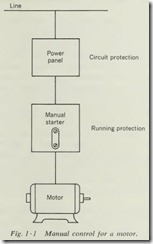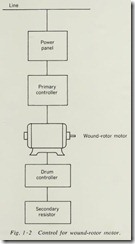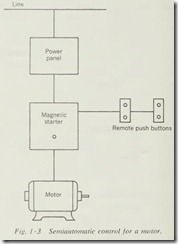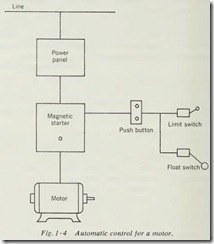Fundamentals of Control
Since the advent of mass production, the machine has become a vital part of our economy. In the beginning machines were operated chiefly by hand and powered from a common line shaft. This line shaft was driven by a large motor that ran continuously and was connected to the individual machine by a belt when needed. It should not be hard to see that this type of power did not lend itself to quantity production.
With the demand for more and more production, the machine took on a new look. Down came the line shaft, and the electric motor went into the individual machine. This change allowed more frequent and more rapid starts, stops, and reversals of the machine. A small machine could have a small high-speed motor, while next to it a large machine could have a large con stant- or variable-speed motor. In other words, the machine shop or factory became more flexible. Once the drive motor was put on the machine, with the sole function of operating one piece of equipment, it was possible to introduce some automatic operations.
Today in our industrial plants, more and more machines are being made fully automatic. The operator merely sets up the original process, and most or all operations are carried out auto matically. The automatic operation of a machine is wholly de pendent upon motor and machine control. Sometimes this con trol is entirely electrical and sometimes a combination of electri cal and mechanical control is used. The same basic principles apply, however.
A modern machine consists of three separate divisions which need to be considered. First is the machine itself, which is de signed to do a specific job or type of job. Second is the motor , which is selected according to the requirements of the machine as to load, duty cycle, and type of operation. Third, and of chief concern in this book, is the control system. The control system design is dictated by the operating requirements of the motor and the machine. If the machine needs only to start, run for some time, and stop, then the only control needed would be a simple toggle switch. If, however, the machine needs to start, perform several automatic operations, stop for a few sec onds, and then repeat the cycle, it will require several integrated units of control.
It is the intent of this book to present the basic principles and components of control and then show how they are put together to make a control system.
1 ·1 MEANING OF CONTROL
“What is motor control?” This is a question that has no simple answer. It is not, however, the mysterious, complicated subject that some people believe it to be.
The word control means to govern or regulate, so it must
follow that when we speak of motor or machine control, we are talking about governing or regulating the functions of a motor or a machine. Applied to motors, controls perform several
functions, such as starting, acceleration , speed, power, protec tion, reversing, and stopping.
Any piece of equipment used to regulate or govern the func tions of a machine or motor is called a control component. Each component will be taken up in a separate section of this book.
An electric controller is a device or group of devices that controls or regulates the functions of a motor or machine in a predetermined manner or sequence.
1 ·2 MANUAL CONTROL
A manual controller is one having its operations controlled or performed by hand at the location of the controller (Fig. 1·1). Perhaps the most popular single type in this category is the manual full-voltage motor starter in the smaller sizes. This starter is used frequently where the only control function needed is to start and stop the motor. Probably the chief reason for the popularity of this unit is the fact that its cost is only about one-half that of an equivalent magnetic starter. The manual starter generally gives overload protection (Sec. 2 ·7) and low voltage release (Sec. 2 ·12), but does not give low-voltage protection.
Manual control which provides the same functions as those achieved by the manual full-voltage motor starter can be had by the use of a switch with fusing of the delayed-action type, which will provide overload protection for the motor.
Examples of this type of control are very common in small metalworking and woodworking shops, which use small drill presses and lathes and pipe-threading machines. Another good example is the exhaust fan generally found in machine shops and other industrial operations. In this installation the operator or maintenance man generally pushes the START button for the fan in the morning when the plant opens, and it continues to run throughout the day. In the evening, or when the plant is shut down, the operator then pushes the STOP button, and the fan shuts down until needed again. The welding machines of the motor-generator type are a very common example of this kind of control and should be familiar to most students of motor control.
The compensator, or manual reduced-voltage starter, is used extensively to control polyphase squirrel-cage motors where re duced-voltage starting is required and the only control functions required are start and stop. The compensator gives overload protection, low-voltage release, and low-voltage protection. The compensator type of starter is quite frequently used in conjunc tion with a drum controller on wound-rotor motors (Fig. 1·2). This combination gives full manual control of start, stop, speed, and direction of rotation .
The compensator, being a reduced-voltage starter, is generally found only on the larger horsepower motors. A very common use for the compensator with the addition of a drum controller is found in the operation of many centrifugal-type air-condition ing compressors. The reduced-voltage feature is used to enable the motor to overcome the inertia of the compressor during start ing without undue current loads on the system. The drum controller, through its ability to regulate speed of a wound-rotor motor, provides a means of varying the capacity of the air-con ditioning system, thus giving a flexibility that would not be pos sible with a constant-speed full-voltage installation.
These are just a few of the manual controllers, but you should have little trouble classifying any unit of this type because it has no automatic functions of control. Manual control is char acterized by the fact that the operator must move a switch or push a button to initiate any change in the condition of operation of the machine or equipment in question.
1·3 SEMIAUTOMATIC CONTROL
Controllers that fall in this classification use a magnetic starter and one or more manual pilot devices such as push buttons, toggle switches, drum switches, and similar equipment (Fig. 1·3). Probably the most used of these is the push-button station because it is a compact and relatively inexpensive unit. Semi automatic control is used mainly to give flexibility of control position to installations where manual control would otherwise be impractical.
The key to classification as a semiautomatic control system lies in the fact that all the pilot devices are manually operated and that the motor starter is the magnetic type. There are prob ably more machines operated by semiautomatic control than by either manual or automatic. This type of control requires the operator to initiate any change in the attitude or operating condition of the machine. Through the use of the magnetic starter, however, this change may be initiated from any conven ient location, as contrasted to the manual-control requirement that the control point be at the starter.
1 ·4 AUTOMATIC CONTROL
An automatic controller is a magnetic starter or contactor whose functions are controlled by one or more automatic pilot devices (Fig. 1·4). The initial start may be automatic, but usu ally it is a manual operation, activated by a push-button station or switch.
In some cases there may be a combination of manual and automatic pilot devices in a control circuit. If the circuit contains one or more automatic devices, it would be classed as an auto matic control. Consider, for example, a tank that must be kept filled with water between definite limits and a pump to replace the water as it is needed. If we equip the pump motor with a manual starter, and station a man at the pump to turn it on and off as needed, we have manual control. Now let us replace the manual starter with a magnetic starter and put a push-button station at the foreman’s desk. If we ring a bell to let him know when the water is low and again when it is high, he can do other work and just push the proper button when the bell rings. This would be semiautomatic control. Now suppose we install a float switch that will close the circuit when the water reaches a predetermined low level and open it when it reaches a predetermined high level. When the water gets low, the float switch will close the circuit and start the motor. The motor will now run until the water reaches the high level, at which time the float switch will open the circuit and stop the motor.
This would be automatic control.
Even though the automatic system would cost more to install than the other two, it requires no attention by an operator, thus saving the cost of his labor. This may well make it the cheapest method to use. The automatic control would be more accurate because there is no delay between the water reaching the desired level and the closing or opening of the control circuit.
Automatic control systems are to be found in almost all ma chine-tool installations. Tools such as drill presses, milling ma chines, shapers, turret lathes, precision grinders, and almost any other type of machine in common use may, through the use of limit switches and other automatic pilot devices, perform their operations more efficiently and rapidly by the use of auto matic control systems.
Summary
The basic difference in manual, semiautomatic, and automatic control lies in the flexibility of the system. With manual control the operator must go to the physical location of the starter to make any change in the operation of the machine. With semi automatic control the operator may have his control point at any convenient location so that he might initiate changes in the operation from the most desirable position. With automatic control the necessity of the operator initiating the necessary changes has been eliminated for each automatic operation that is included in the control system.



